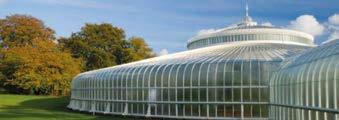
4 minute read
19 Museums
Our Museums areFREE to visit
Anew book, Coming Into View: Eric Watt's Photographs of Glasgow, is an evocative collection of almost 100 images, skillfully captured by the late, amateur photographer Eric Watt.
Advertisement
They are part of a huge body of work his family donated to Glasgow Museums after his death.
Some of the most well-known aspects of city life are depicted in his photographs. The book includes essays about Eric Watt’s life and career, written by Glasgow Museums' Curators Isobel McDonald, and by Alison Brown.
Graham Watt, Eric Watt’s brother, said: “It all started when Eric was 13. He got a small camera for Christmas in 1947. I got nothing so exciting.
And so he acquired an interest which absorbed him for the rest of his life. He always left the house with at least two cameras round his neck should he see something of interest, which he nearly always did.
Then it was back to his bedroom which had a huge cabinet containing all his developing paraphernalia. He then spent the evenings mounting his slides and finally the family were entertained to a show among which are the historical pictures contained in this book.
We are very proud that somewhat late in the day he should be afforded this recognition and my thanks are due to Glasgow Museums for making this possible.”
Available to order from BookSource
Fine art, historic objects, natural history and arms and armour, brought together and exhibited in some of the city’s most beautiful public buildings ... what’s not to like?
GALLERY OF MODERN ART (GOMA)
Royal Exchange Square, Glasgow, G1 3AH 0141 287 3050 www.glasgowlife.org.uk/museums/venues/ gallery-of-modern-art-goma Scotland’s most visited modern art gallery. Housed in an iconic 18th century building in the heart of Glasgow, GoMA is the centre for the city’s modern and contemporary art collections. Glasgow is world-famous for the artists who live and study here, and GoMA showcases and reflects Glasgow artists’ dominance on the global visual arts scene.
PEOPLE’S PALACE & WINTER GARDENS
Glasgow Green, Templeton Street, G40 1AT 0141 276 0788 www.glasgowlife.org.uk/museums/venues/ peoples-palace Our museum of Glasgow’s history explores the story of the city and its people, from 1750 to the late 20th century, through objects, paintings and photographs. Find out how ordinary Glaswegians lived, worked and played in the many colourful displays. You can visit the Single End to see the cramped living conditions endured by many people, or see the Steamie, where housewives went to wash their families’ clothes in the days before washing machines.
PROVANDS LORDSHIP
Castle Street, Glasgow, G4 0RB 0141 276 1625 www.glasgowlife.org.uk/museums/venues/ provands-lordship Provand’s Lordship was built in 1471. It is one of only four surviving medieval buildings in Glasgow. The “auld hoose” is furnished with a fine selection of 17th-century historic furniture and royal portraits. Step back into medieval Glasgow with a visit to this fascinating building. Behind the building sits the St Nicholas Garden, a herb garden which is an oasis of calm, away from the hustle and bustle of the city.
ST MUNGO MUSEUM OF RELIGIOUS LIFE & ART
Castle Street, Glasgow, G4 0RH 0141 276 1625 www.glasgowlife.org.uk/museums/venues/stmungo-museum-of-religious-life-and-art St Mungo Museum is part of the historic cathedral precinct and explores religion and its importance in Scotland, across the world and across time. There are three permanent galleries with displays relating to some of the world’s major religions, stunning works of religious art and a chance to discover more about religion in Scotland. The upper floor of the museum boasts unrivalled views of the Cathedral and the Necropolis.
SCOTLAND STREET SCHOOL
Scotland Street, Glasgow, G5 8QB 0141 287 0500 www.glasgowlife.org.uk/museums/venues/ scotland-street-school-museum Scotland Street School was designed by Charles Rennie Mackintosh between 1903-1906 for the School Board of Glasgow. With many features built into the stonework and staircases, there is something to admire around every corner! Now as a museum, it tells the story of 100 years of education in Scotland, from the late 19th century to the late 20th century.Find out what school days were like in the reign of Queen Victoria, during World War II, and in the 1950s and 60s, in our three reconstructed classrooms. You can even dress up as a pupil from the past!
RIVERSIDE MUSEUM
Pointhouse Place, Glasgow, G3 8RS 0141 287 2720 www.glasgowlife.org.uk/museums/venues/ riverside-museum Scotland’s Museum of Transport and Travel showcases all forms of transport from prams to locomotives! This spectacular museum was designed by the internationally renowned architect Zaha Hadid and sits on the banks of the River Clyde, site of the famous Clyde shipbuilding industry. The museum features the largest object in Glasgow Museums’ collection, the South African Railways locomotive 3007, as well as the world’s oldest bicycle and a recreated early 1900’s street. This is no conventional transport museum though – the stories of the people who made, drove and used transport are
MUSEUM
centre-stage with the objects.
KELVINGROVE ART GALLERY & MUSEUM
Argyle Street, Glasgow, G3 8AG 0141 276 9599 www.glasgowlife.org.uk/museums/venues/kelvingrove-art-gallery-and-museum Opened in 1901, Glasgow’s favourite building houses over 8,000 objects in 22 galleries of fine art, history, natural history, arms and armour and decorative art. Highlights in fine art include Dali’s Christ of St John of the Cross, The Young Girls by Mary Cassat and Portrait of Alexander Reid by Van Gogh. In decorative art, there is a gallery dedicated to Charles Rennie Mackintosh and the Glasgow Style, featuring stunning examples of his work in furniture and design.
THE BURRELL COLLECTION
Pollokshaws Road, Pollok Country Park, Glasgow, G43 1AT www.glasgowlife.org.uk/museums/venues/the-burrell-collection The Burrell Collection is closed for refurbishment until 2021 but the Burrell Collection’s renaissance is providing the opportunity to redisplay and reinterpret this wonderful collection, and will reveal many new stories about individual objects. When the museum re-opens, over a third more gallery space will allow important and unique objects, which have not been seen for decades or have never been on permanent display to be exhibited.










